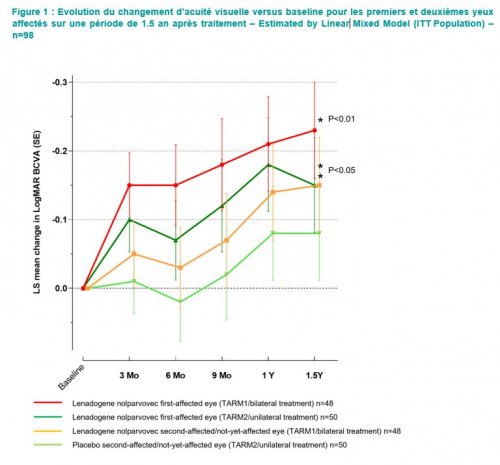Paris, France, November 17, 2022, 7:30 am CET – GenSight Biologics (Euronext: SIGHT, ISIN: FR0013183985, PEA-PME eligible), a biopharma company focused on developing and commercializing innovative gene therapies for retinal neurodegenerative diseases and central nervous system disorders, today announced that the highly regarded neurology journal BRAIN has published efficacy and safety findings at 1.5 Year post-treatment in ND4-LHON patients treated with lenadogene nolparvovec (LUMEVOQâ) from the REFLECT Pivotal clinical trial.
The REFLECT results, whose topline findings were announced by the company on 30th June 2021, show statistically significant visual acuity improvement in ND4-LHON patients from baseline in LUMEVOQ® treated eyes, with an additional effect for bilaterally injected patients in comparison with a unilateral treatment (Figure 1). A good safety profile was observed and was comparable in unilaterally and bilaterally treated patients demonstrating the positive outcome of bilateral injections of LUMEVOQ®.
“These results demonstrate that LUMEVOQ produces a significant improvement in visual acuity for LHON patients, with a likely additional effect when patients are treated bilaterally,” said Patrick Yu-Wai-Man[1], MD, PhD, Professor of Ophthalmology and Honorary Consultant Neuro-ophthalmologist at the University of Cambridge, Moorfields Eye Hospital, and the UCL Institute of Ophthalmology, United Kingdom, and Principal Investigator of REFLECT. “They also show that this efficacy is achieved with a good safety profile. This gene therapy represents a real hope for patients affected by this devastating blinding disease.”
REFLECT is the third Phase III clinical trial evaluating the efficacy and safety of lenadogene nolparvovec in ND4-LHON patients. It is also the first clinical trial assessing the efficacy of a bilateral intravitreal injection (IVT) of LUMEVOQâ, while in the three previous trials REVEAL1, REVERSE2,3,4 and RESCUE,3,4,5 it was exclusively administered as unilateral IVT. With the completion of REFLECT, LUMEVOQâ has been administered to 189 patients across four clinical trials.
The paper, entitled “Randomised trial of bilateral injection of lenadogene nolparvovec for m.11778G>AMT-ND4 Leber hereditary optic neuropathy”, is available in print and online via this link.

Note: The figure above shows results from a linear mixed model (considering both eyes of each patient) using treatment and baseline value as fixed effects, and intercept per patient as random effect. Data shown are LS means.
In addition, the BMJ Open Ophthalmology, an international peer-reviewed journal, published analysis of characteristics of the ND4-LHON patients before treatment from the REFLECT trial. The article, titled “Study Design and Baseline Characteristics for the REFLECT Gene Therapy Trial of m.11778G>A/ND4-LHON” is available online on this link.
The analyses of the REFLECT trial population before treatment show demographic characteristics, visual function, and retinal anatomic measurements consistent with the natural history of the ND4-LHON disease6.
“The profile of REFLECT patients, viewed together with those of REVERSE and RESCUE, provide important information on the inferred natural history of ND4-LHON that should help guide future research in subjects with the m.11778G>A mutation” said Prem Subramanian, MD, PhD, Professor of Ophthalmology, Neurology, and Neurosurgery at the Sue Anschutz-Rodgers University of Colorado Eye Center and REFLECT Principal Investigator.”
[1] Patrick Yu-Wai-Man:
- Cambridge Centre for Brain Repair and MRC Mitochondrial Biology Unit, Department of Clinical Neurosciences, University of Cambridge, Cambridge, UK.
- Cambridge Eye Unit, Addenbrooke’s Hospital, Cambridge University Hospitals, Cambridge, UK.
- Moorfields Eye Hospital, London, UK
- UCL Institute of Ophthalmology, University College London, London, UK
References
1 Vignal-Clermont C, Girmens JF, Audo I, et al. Safety of intravitreal gene therapy for treatment of subjects with Leber hereditary optic neuropathy due to mutations in the mitochondrial ND4 gene: the REVEAL study. Biodrugs. 2021;35(2):201-214.
2 Yu-Wai-Man P, Newman NJ, Carelli V, et al. Bilateral visual improvement with unilateral gene therapy injection for Leber hereditary optic neuropathy. Sci Transl Med. 2020;12(573):eaaz7423.
3 Moster ML, Sergott RC, Newman NJ, et al. Cross-sectional analysis of baseline visual parameters in subjects recruited into the RESCUE and REVERSE ND4-LHON gene therapy studies. J Neuroophthalmol. 2021;41(3):298-308.
4 Newman NJ, Yu-Wai-Man P, Carelli V, et al. Intravitreal gene therapy vs. natural history in patients with Leber hereditary optic neuropathy carrying the m.11778G>A ND4 mutation: systematic review and indirect comparison. Front Neurol. 2021;12:662838.
5 Newman NJ, Yu-Wai-Man P, Carelli V, et al. Efficacy and safety of intravitreal gene therapy for Leber hereditary optic neuropathy treated within 6 Months of disease onset. Ophthalmology. 2021;128(5):649-660.
6 Newman NJ, Carelli V, Taiel M, Yu-Wai-Man P. Visual outcomes in Leber hereditary optic neuropathy patients with the m.11778G>A (MTND4) mitochondrial DNA mutation. J Neuro-Ophthalmol Off J North Am Neuro-Ophthalmol Soc. 2020;40(4):547-557.
Contacts
-
LifeSci AdvisorsInvestor RelationsGuillaume van Renterghem+41 (0)76 735 01 31